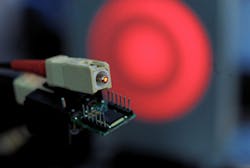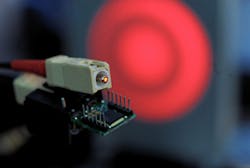Siemens touts 1-Gbit transmission over polymer fiber cables
JUNE 6, 2007 -- Researchers at Siemens Corporate Technology (search for Siemens) say they have set a new record for data transmission in optical polymer fiber cables. Thanks to a new data transmission technique, they have succeeded in sending 1 Gbit/sec down the plastic fibers--ten times more than with products currently on the market, say Siemens representatives, who hope this milestone finally enables polymer fibers to become established in the home entertainment sector and in factory automation.
In theory, polymer fiber cables would enable every layman to set up high-speed data links in his or her home network. Small converter boxes convert the electrical signal from the copper cable into an optical signal. Thin cables, which are made of plastic and transport the optical signal to receivers anywhere in the home, can be easily connected to these boxes. Because of the very high transmission rate of these polymer fiber cables, television signals with high data volumes also could be transmitted within the home in this way in the future, says Siemens.
Until now, however, polymer fibers have suffered from the crucial disadvantage that their transmission capacity has been limited to 100 Mbits/sec. Although that is sufficient at the present time for DSL, Internet telephony, and Internet TV, experts are certain that one Gigabit (or 1000 Mbits) will soon be required to support the rapidly increasing transmission capacity in the Internet.
Now researchers at Siemens Corporate Technology say they have broken the sound barrier and set a new record worldwide. Thanks to a new technique for data transmission, they claim to have transmitted 1 Gbit/sec over a 100-meter-long test route in the laboratory--without errors or flickering on the screen. This would be long enough for application in the household, they say.
The trick for getting optical polymer fiber cables to operate at Gigabit speeds is that the bits are not sent as usual light pulses as in the past. Instead, the Siemens researchers applied a special algorithm that changes the light signals in such a way that more information fits into the available bandwidth of the polymer fibers. The researchers have adapted the familiar multi-carrier modulation technique used in DSL and WLAN so that it is also applicable to light signals.
"Thanks to quadrature amplitude modulation with up to 256 signal states, the so-called bandwidth efficiency measured in bits per second and hertz can be increased significantly," explains Sebastian Randel, project manager at Siemens Corporate Technology. Using this algorithm, the researchers could transmit exactly 1008 Mbits/sec through a polymer fiber cable.
As a result, polymer fibers are not only suitable for the future in private homes but also for industrial automation applications where these rugged, low cost cables have long been established as the standard. They are used to connect machine tools or robots together and to link them to the central control unit. Like the communications sector, ever higher data rates are called for in the industrial automation industry, which is also aiming to attain the Gigabit mark. And Randel says he sees even more potential applications for high-speed polymer fibers in the automotive industry, in the controlling of wind turbines, and particularly in medical technology where data volumes are growing at a rapid pace due to the constant increase in the resolution of imaging processes such as computed tomography.
Visit Siemens Corporate Technology
